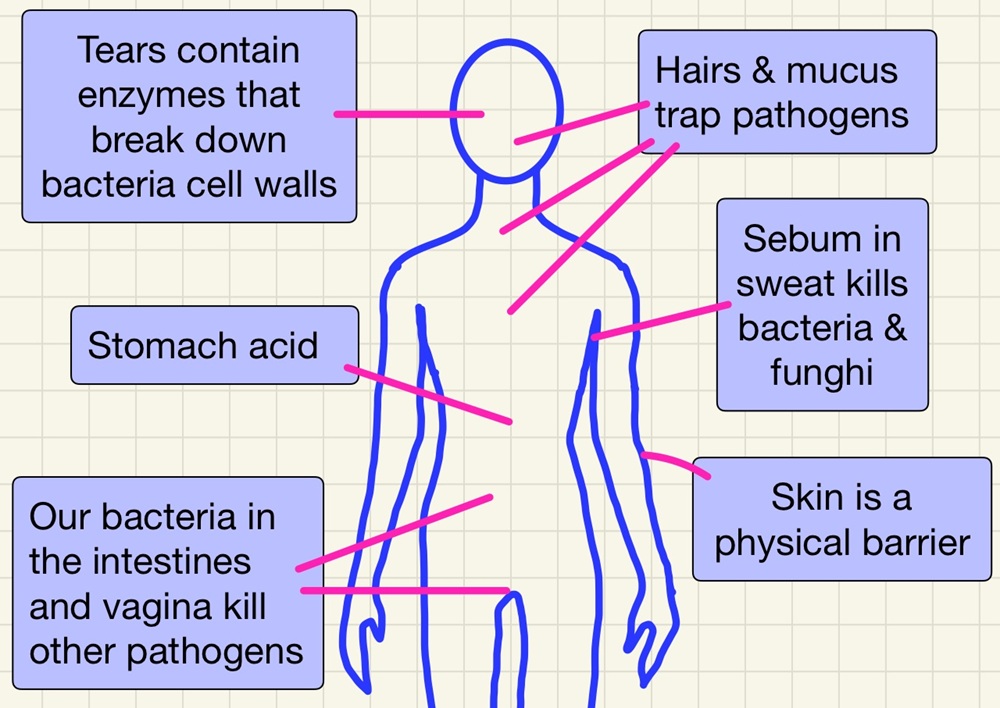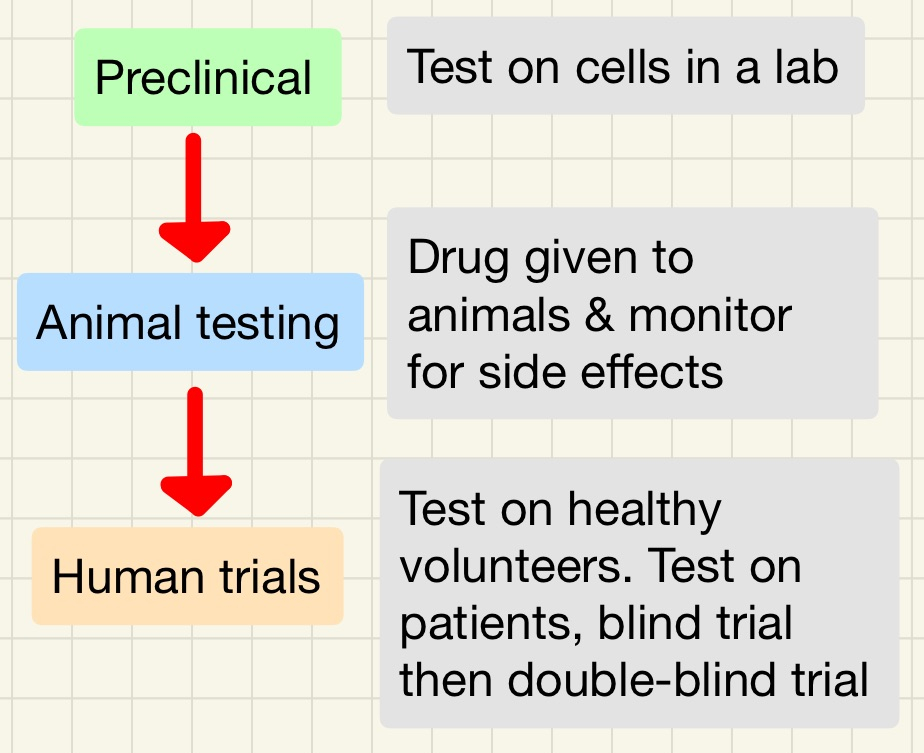Infection and Response
What we are learning:
Communicable diseases and types of pathogens:

A communicable disease is one that is caused by a pathogen and so is infectious. There are 4 types of pathogens that you need to know about, they are listed below with some examples:
• Bacteria: Cholera, tuberculosis, chlamydia, .
• Virus: HIV/AIDS, Ebola, COVID-19, chicken pox.
• Fungi: Athlete's foot.
• Protist: Malaria.
The spread of these infectious diseases can be reduced by good hygiene. We all had lots of practice with this during the COVID-19 pandemic. Washing hands, covering mouth/nose when coughing and sneezing, isolating infected people until they are no longer contagious, destroying vectors (mosquitos carrying the protists or rats with infected fleas) and finally vaccination. Humans can pick up bacteria from food such as salmonella from contaminated food and sexually transmitted infections such as gonorrhoea if they do not use condoms.
Human defences against disease:

The best defence is to keep the pathogens out and we have evolved may excellent ways of doing this. We have a skin barrier, tears that wash debris and pathogens out of our eyes, ciliated cells that catch debris and pathogens if we breathe them in, stomach acid to kill pathogens attached to our food and acidic genital areas which are areas more susceptible for microbial entry.
If these defences are breached, a virus will enter a healthy living cell and replicate. This damages the cell and releases more viruses to infect other cells. Bacteria release toxins which make us feel unwell as well as damaging local cells, tissues and organs. Our immune system will now step in to destroy these invading pathogens. Our white blood cells will support us in three ways:
• The process of phagocytosis is when bacteria are surrounded and engulfed by white blood cells. The results are easily seen as the yellow puss/discharge in a wound or spot.
• The production of antibodies. These are specific to the pathogen as these antibodies attack the antigens on the surface of the pathogen. Once the white blood cell knows how to make they appropriate antibodies, they can spring into action very quickly and make more.
• The production of antitoxins.These do not kill off the pathogen but they make us feel less unwell by neutralising the toxins.
Vaccinations:

We just saw in the previous component that white blood cells need to meet a pathogen, assess the antigens on its surface then synthesise the appropriate antibodies to destroy it. This all takes time and we become ill while it happens. This is where vaccinations come in. By introducing a person to a weakened of dead pathogen (injection or nasal spray), the body can make antibodies for that pathogen and learn how to kill it. This is then remembered by the body's immune system so when the real pathogen arrives, the white blood cells can spring into action much faster and kill off the infection before the patient feels ill.
If a large enough proportion of the population is immune, then the strength of the pathogen is diminished. There was a lot of discussion in the media about herd immunity during the COVID-19 pandemic.
Antibiotics & painkillers:

Antibiotics are drugs that kill off bacteria that have invaded our bodies, the most common one to use is penicillin. There are a number of different ones and they are used to target specific bacteria. Note that they only kill bacteria, there is no point in using them against a cold or flu, they will not only fail to help with the virus, they can have other very negative effects. Penicillin was discovered by Alexander Fleming when a mould grew on a bacteria plate and prevented the bacteria from spreading.
Overuse of antibiotics is to be avoided at all costs, although there is the concern that your own immune system will not get to test itself, it can contribute to the emergence of antibiotic resistant strains. In these cases, a person with an infection in their foot that does not respond to antibiotics may be left with the only option of amputation to prevent the spread of the disease.
Painkillers do not kill the pathogen, instead they treat the symptoms. They make you feel better and can reduce the fever
Drug development:

The pharmaceutical industry is worth trillions of pounds globally. It began with natural remedies that were traditionally extracted from plants and other natural resources. Today, drugs are synthesised by chemists based on structures that we know will work and interact and trying out new ground-breaking ideas. They often start with something know that can be extracted from a plant and tweaking the structure until a different combination has a desired effect.
When a new drug has been made, it has to be thoroughly tested, firstly to ensure that it is not toxic to humans, then that it will actually do the job to humans that it is supposed to do and then to ensure that there are no unwanted side effects. It is first tested in a lab then there will be clinical trials on healthy volunteers, and finally it will be tested on consenting patients to measure the success of the drug on the target group.
To remove bias and ensure the validity of a drugs trial, a double-blind trial is completed. In this there are two groups of patients, one group has a placebo and the other group has the new drug. Neither the patients not the doctors measuring the effects know who has the real drug and who has the placebo.
Key words/terms for this topic
Antibiotic resistance Antibiotics Antibodies Antigens Antitoxins Artificial heart Bacteria Benign Carcinogen Cardiovascular Cholesterol Communicable Coronary heart disease Dose Double-blind Trial Efficacy Fungicide Fungus Health Herd immunity Immunity Isolation Malignant Mimic Mucus Non-communicable Pathogen Peer review Phagocytosis Placebo Protozoa Risk factor Salmonella Sexually transmitted disease (STD) Statin Stent Toxicity Toxin Transplant Tumour Vaccination Vector Virus White blood cell
Curriculum Health Check:
Q: Which of these is not caused by bacteria?
A: Pneumonia
B: Salmonella
C: Influenza
D: Gonorrhoea
What you need to know
Infections diseases (communicable) are spread by the 4 pathogens. Bacteria, Virus, Protists Fungi. There microorganisms can be spread by contact, air or water. Viruses live and reproduce in cells which damage them whereas bacteria produce toxins that damage cells and make us feel unwell.

You need to be aware of how our bodies prevent pathogens from entering the body and things that we can do to reduce the chances of infection.

You need to understand a variety of diseases such as:

• (VIRUS) measles, HIV, TMV,

• (BACTERIA) salmonella, gonorrhoea,

• (FUNGAL) rose black spot,

• (PROTIST) malaria.

You need to understand the process of how vaccines work as well as how antibiotics and painkillers can be used. It is very important to understand why antibiotics should never be used to overcome a virus.

The final process is the complicated steps involved in discovering, developing and testing new drugs. Know and understand the steps in each stages and the importance. Know how why there is a placebo and double blind trials. Be aware of lessons from the past such as Thalidomide.

This page was updated on: 14th April 2024


